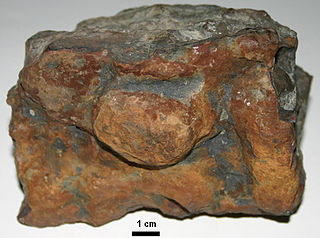Related Research Articles
Geology is a branch of natural science concerned with the Earth and other astronomical objects, the rocks of which it is composed, and the processes by which they change over time. Modern geology significantly overlaps all other Earth sciences, including hydrology. It is integrated with Earth system science and planetary science.

Sandstone is a clastic sedimentary rock composed mainly of sand-sized silicate grains. Sandstones comprise about 20–25% of all sedimentary rocks.

Marl is an earthy material rich in carbonate minerals, clays, and silt. When hardened into rock, this becomes marlstone. It is formed in marine or freshwater environments, often through the activities of algae.

Ironstone is a sedimentary rock, either deposited directly as a ferruginous sediment or created by chemical replacement, that contains a substantial proportion of an iron ore compound from which iron (Fe) can be smelted commercially. Not to be confused with native or telluric iron, which is very rare and found in metallic form, the term ironstone is customarily restricted to hard, coarsely banded, non-banded, and non-cherty sedimentary rocks of post-Precambrian age. The Precambrian deposits, which have a different origin, are generally known as banded iron formations. The iron minerals comprising ironstones can consist either of oxides, i.e. limonite, hematite, and magnetite; carbonates, i.e. siderite; silicates, i.e. chamosite; or some combination of these minerals.

Palynology is the study of microorganisms and microscopic fragments of mega-organisms that are composed of acid-resistant organic material and occur in sediments, sedimentary rocks, and even some metasedimentary rocks. Palynomorphs are the microscopic, acid-resistant organic remains and debris produced by a wide variety plants, animals, and Protista that have existed since the late Proterozoic.

Greensand or green sand is a sand or sandstone which has a greenish color. This term is specifically applied to shallow marine sediment that contains noticeable quantities of rounded greenish grains. These grains are called glauconies and consist of a mixture of mixed-layer clay minerals, such as smectite and glauconite. Greensand is also loosely applied to any glauconitic sediment.
Diamicton is a terrigenous sediment that is unsorted to poorly sorted and contains particles ranging in size from clay to boulders, suspended in an unconsolidated matrix of mud or sand. Today, the word has strong connotations to glaciation but can be used in a variety of geological settings.

A pelite or metapelite is a metamorphosed fine-grained sedimentary rock, i.e. mudstone or siltstone. The term was earlier used by geologists to describe a clay-rich, fine-grained clastic sediment or sedimentary rock, i.e. mud or a mudstone, the metamorphosed version of which would technically have been a metapelite. It was equivalent to the now little-used Latin-derived term lutite. A semipelite is defined in part as having similar chemical composition but being of a crystalloblastic nature.

Arenite is a sedimentary clastic rock with sand grain size between 0.0625 mm (0.00246 in) and 2 mm (0.08 in) and contain less than 15% matrix. The related adjective is arenaceous. The equivalent Greek-derived term is psammite, though this is more commonly used for metamorphosed sediments.

Red beds are sedimentary rocks, typically consisting of sandstone, siltstone, and shale, that are predominantly red in color due to the presence of ferric oxides. Frequently, these red-colored sedimentary strata locally contain thin beds of conglomerate, marl, limestone, or some combination of these sedimentary rocks. The ferric oxides, which are responsible for the red color of red beds, typically occur as a coating on the grains of sediments comprising red beds. Classic examples of red beds are the Permian and Triassic strata of the western United States and the Devonian Old Red Sandstone facies of Europe.

Sole marks are sedimentary structures found on the bases of certain strata, that indicate small-scale grooves or irregularities. This usually occurs at the interface of two differing lithologies and/or grain sizes. They are commonly preserved as casts of these indents on the bottom of the overlying bed. This is similar to casts and molds in fossil preservation. Occurring as they do only at the bottom of beds, and their distinctive shapes, they can make useful way up structures and paleocurrent indicators.

In geology, a bed is a layer of sediment, sedimentary rock, or volcanic rock "bounded above and below by more or less well-defined bedding surfaces". Specifically in sedimentology, a bed can be defined in one of two major ways. First, Campbell and Reineck and Singh use the term bed to refer to a thickness-independent layer comprising a coherent layer of sedimentary rock, sediment, or pyroclastic material bounded above and below by surfaces known as bedding planes. By this definition of bed, laminae are small beds that constitute the smallest (visible) layers of a hierarchical succession and often, but not always, internally comprise a bed.
The Society for Sedimentary Geology is an international not-for-profit, scientific society based in Oklahoma. It is commonly referred to by its acronym SEPM, which refers to its former name, the Society of Economic Paleontologists and Mineralogists.
Psammite is a general term for sandstone. It is equivalent to the Latin-derived term arenite and is commonly used in various publications to describe a metamorphosed sedimentary rock with a dominantly sandstone protolith. In Europe, this term was formerly used for a fine-grained, fissile, clayey sandstone. Pettijohn gives the following descriptive terms based on grain size, avoiding the use of terms such as "clay" or "argillaceous", which carry an implication of chemical composition:
Lutite is old terminology, which is not widely used, by Earth scientists in field descriptions for fine-grained, sedimentary rocks, which are composed of silt-size sediment, clay-size sediment, or a mixture of both. When mixed with water lutites often disintegrate into mud. Because this is a field term, there is a lack of any precise definition for it based upon specific grain-size characteristics. Lutites include a variety of fine-grained sedimentary rocks, including calcisiltite, calcilutite, claystone, mudstone, shale, and siltstone. It is equivalent to the term mudstone and the Greek-derived term pelite. Lutite was first used in 1904 by Grabau, who derived it from lutum, the Latin word for mud. He also proposed a number of prefixes to be used with and attached to "lutite" in order to designate various types of lutites. None of these prefixes are used by Earth scientists nowadays.
Rudite is a general name used for a sedimentary rock composed of rounded or angular detrital grains, i.e. granules, pebbles, cobbles, and boulders, which are coarser than sand in size. Rudites include sedimentary rocks composed of both siliciclastic, i.e. conglomerate and breccia, and carbonate grains, i.e. calcirudite and rudstone. This term is equivalent to the Greek-derived term, psephite. Rudite was initially proposed by Grabau as "rudyte." It is derived from the Latin word rudus for "crushed stone," "rubbish," "debris," and "rubble".

In structural geology, a homocline or homoclinal structure, is a geological structure in which the layers of a sequence of rock strata, either sedimentary or igneous, dip uniformly in a single direction having the same general inclination in terms of direction and angle. A homocline can be associated with either one limb of a fold, the edges of a dome, the coast-ward tilted strata underlying a coastal plain, slice of thrust fault, or a tilted fault block. When the homoclinal strata consists of alternating layers of rock that vary hardness and resistance to erosion, their erosion produces either cuestas, homoclinal ridges, or hogbacks depending on the angle of dip of the strata. On a topographic map, the landfroms associated with homoclines exhibit nearly parallel elevation contour lines that show a steady change in elevation in a given direction. In the subsurface, they characterize by parallel structural contour lines.

In sedimentology, imbrication is a primary depositional fabric consisting of a preferred orientation of clasts such that they overlap one another in a consistent fashion, rather like a run of toppled dominoes. Imbrication is observed in conglomerates and some volcaniclastic deposits.

A cobble is a clast of rock defined on the Udden–Wentworth scale as having a particle size of 64–256 millimeters (2.5–10.1 in), larger than a pebble and smaller than a boulder. Other scales define a cobble's size differently. A rock made predominantly of cobbles is termed a conglomerate. Cobblestone is a building material based on cobbles.
Francis John Pettijohn was an American geologist who served for many years on the faculty of Johns Hopkins University.
References
- ↑ ψῆφος . Liddell, Henry George ; Scott, Robert ; A Greek–English Lexicon at the Perseus Project.
- ↑ Neuendorf, K.K.E., J.P. Mehl, Jr., and J.A. Jackson, J.A., eds. (2005) Glossary of Geology (5th ed.). Alexandria, Virginia, American Geological Institute. 779 pp. ISBN 0-922152-76-4
- ↑ Pettijohn F. J. (1975), Sedimentary Rocks, Harper & Row, ISBN 0-06-045191-2